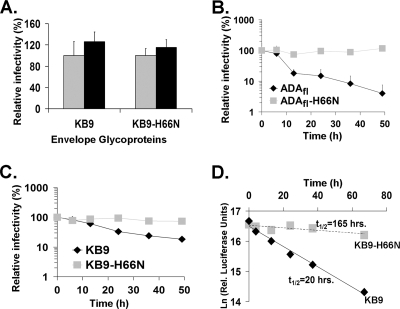FIG. 2.
Rate of cold inactivation of virus infectivity. (A) Recombinant viruses with wild-type KB9 or KB9-H66N envelope glycoproteins were kept at room temperature (gray) or frozen at −80°C (black). Frozen viruses were thawed, and their infectivities were compared with those of viruses kept at room temperature. (B and C) Recombinant viruses bearing the wild-type ADAfl or ADAfl-H66N (B) and wild-type KB9 or KB9-H66N (C) envelope glycoproteins were incubated on ice for various lengths of time. At the indicated time points, aliquots were removed and frozen at −80°C. After completion of the longest incubation, all samples were thawed and infectivity was assayed on Cf2Th-CD4/CCR5 (for ADAfl and ADAfl-H66N) and on Cf2Th-CD4/CXCR4 cells (for KB9 and KB9-H66N). Relative infectivity is the percentage of infection of the same virus not incubated on ice but kept at −80°C. Data are representative of results from three independent experiments performed in triplicate. (D) The half-lives of inactivation of viruses bearing the wild-type KB9 or KB9-H66N envelope glycoproteins after exposure to 0°C were calculated.

